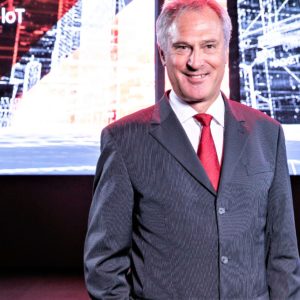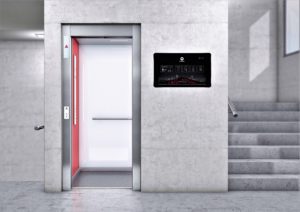Digital tech’s new people-moving ideas for cities in the clouds

As new skyscrapers fill Hong Kong’s skyline, escalator and lift providers are trying to reach new heights in urban mobility.
Hong Kong has the most skyscrapers of any city in the world, according to The Skyscraper Center, a database maintained by the Council on Tall Buildings and Urban Habitat. The city currently has 351 completed buildings higher than 150 metres (492 feet).
Schindler Group, a Switzerland-based escalator and lift manufacturer currently has more than 10,000 pieces of people-moving equipment of various types installed in Hong Kong. That includes lifts in some of the tallest buildings in the city such as the International Commerce Centre (ICC) in West Kowloon, Great Eagle Centre in Wan Chai, One Island East in Quarry Bay, and K11 in Tsim Sha Tsui.
Schindler has been stepping up its game in lift design. That includes the infusion of ‘smart’ elements such as Internet of Things (IoT) interfaces, digital centralised control, and even biotech, into its products.
The inconvenience of climbing up a staircase when a lift stops working is known to most. Some people are familiar with the unpleasant experience of being trapped in a broken one.
“In Hong Kong, an elevator has an average of five malfunctions each year,” stated Markus Staudenmann, chief executive of Schindler Digital Group Ltd, a unit formed in 2016 by Schindler Group, and that specialises in digital innovations in the industry.
“Depending on usage or traffic, the industry norm is that we can have between zero and six issues [per year] coming from wear and tear, vandalism, mechanical issues, software, ventilation [issues] and more,” he added, in an interview with Innovation Hong Kong.
Centralised control
In order to reduce the number of malfunctions, Schindler Digital Group has developed what it calls a closed loop control system – Schindler Ahead – to address problems or ideally to prevent them from happening. An IoT platform is used to analyse cloud-based data in real time to anticipate and resolve potential hazards associated with a particular lift before actual problems arise.
“It aims to improve uptime [time in use], provide insights and offer convenience to passengers during the journey,” said Mr Staudenmann.
With the Schindler Ahead solution, the firm’s lift controllers can gather real-time information about the quality of the equipment’s operation – including any vibration, or door movement, car speed or temperature fluctuation – and its energy consumption, and send it for analysis by cloud-based software. The Schindler Ahead system can also be applied to third-party lifts by equipping them with special sensors.
Signs of potential problems with the lift’s operation can be remotely detected and insights can be can be automatically sent to technicians – via mobile-based applicationsfor prescriptive maintenance. The Schindler Ahead solution makes use of advanced analytics and machine-learning algorithms to generate requests for preventive maintenance.Building owners and facility managers can also review the lift’s operational performance via a mobile app.
Passengers can also collect information on the lift’s operational performance via a mobile app, which is connected to Schindler’s data cloud system.
“The solution adds value to our customers, with higher uptime; and provides insights to building owners and facility managers. It offers convenience and creates better passenger experiences,” Mr Staudenmann said.

Seamless transit
Schindler Digital Group is also working on other innovative smart mobility products, to make the life of Hong Kong people easier when taking a lift.
They include concepts that would allow a lift to feed information to its passengers such as arrival time at the chosen destination; could let a would-be passenger place the lift on standby before entering it; or automatically bring a passenger to the destination floor without the need for the person to press any buttons. Schindler offers such possibilities via myPORT, the company’s mobile software app that aims to offer a more seamless and personalised transit within buildings.

Through the myPORT app, the mobile phone of the potential user of the lift is detected by a remote server once the person enters the building. The system then assigns a lift – in those buildings with multiple lifts – to the person, and the lift automatically takes the user to a destination floor preselected by the user, without the need for further human-computer interaction.
A lift with such capability is also able to anticipate user preferences on interior lighting and how long the doors should stay open or how quickly they should close.
“The solution personalises the mobility experience for users and at the same time ensures building security,” said Mr Staudenmann.
Users can also send special authorisation codes via mobile phone text messages to grant access to others visiting the building. Alternatively, app users can grant temporary admission to either delivery personnel or other visitors. In those cases, the myPORT app can open an outer door of the property, assign a pre-programmed lift and even remotely unlock the apartment or office door, if desired.
Facial recognition, robotics
Facial recognition technology is also being applied to Schindler Digital Group products. Face images of building occupants are first stored in a recognition device, with a comparison module used to verify the set occupants to guarantee safety.
“The technology won’t get users’ personal information but only their facial features,” Mr Staudenmann noted. “Buildings will be more automated in the future and that means they will be able to respond to users’ needs.”
Facial recognition-enabled lifts are already in use in some of the newest top-tier office towers in Shanghai and Beijing. The technology is expected to arrive Hong Kong in the next six months, he said.
In collaboration with the Council of Tall Buildings and Urban Habitat, Schindler has also developed a robotic system for installing lifts, letting self-climbing robots do the heavy lifting.
“The robotic system aims to improve the quality of the elevator, because the robots can drill more accurate holes and set more precise anchor bolts on walls to improve the precision of guide rail installation. This significantly reduces safety risks for workers,” Mr Staudenmann stated.
The technology was recently tried out in high-rise commercial complexes and residential buildings in Europe, he added.